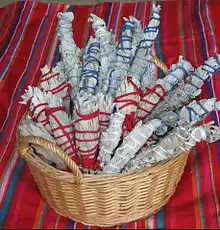Smudging
Smudging generally refers to the practice of burning herbal material. It can be done for practical reasons or for spiritual or ceremonial purposes.
| Part of a series on |
| Indigenous rights |
|---|
| Rights |
| Governmental organizations |
| NGOs and political groups |
| Issues |
| Legal representation |
| Category |

Non-ritual smudging
The 1868 book Life Among the Mormons describes using "a smudge of sage-brush" for repelling mosquitos. In 19th and early 20th century texts, the term "smudge" or "smudge stick" could often refer to a type of insect repellent, with no magical or ceremonial implications.[1] [2] The original sense of the English word smudge, "a suffocating smoke,"[3] also survives in the term smudge-pot.
The Oxford English Dictionary's oldest citation of the term smudging as a verb is from 1599, in reference to the preparation of smoked fish.
Native American traditions
In some First Nations and Native American ceremonies, certain herbs are traditionally used to purify or bless people and places.[4] However, the same herbs that are burned by one culture may be taboo to burn in another, or they may be used for a completely different purpose. When specific herbs are burned ceremonially, this may or may not be called "smudging", depending on the culture.
Traditionally, when gathering herbs for ceremonial use, care is taken to determine the time of day, month, or year when the herbs should be collected; for example, at dawn or evening, at certain phases of the moon, or according to yearly cycles. Gertrude Allen, a Lumbee, reported that her father, an expert in healing with plants, stated that sage varies in potency at different times of the year.[5]
While sage is commonly associated with smudging and several Native American or FNIM cultures may use forms of sage (for example, common sage or white sage) that are local to their region, the use of sage is neither universal, nor as widespread as was once commonly believed.
Controversy
Use of smudges have also been adopted in some forms into a number of modern belief systems. This has been protested against by Native activists as a form of cultural misappropriation.[6][7]
Native American students in college dorms have at times faced harassment and been forbidden from burning herbs for ceremonial reasons due to university fire prevention policies that prohibit the burning of candles or incense in college dorm rooms. This has raised issues around the religious freedom of Native Americans.[8] In another account, a Native American in Cincinnati became ordained by the Universal Life Church in order to fulfill the requirement that only clergy members could perform smudging ceremonies as part of the prayer ritual for other Native Americans in area hospitals.[9]
Ritual smudge in other cultures
Other cultures worldwide may burn herbs or incense for spiritual purposes, such as in smoking ceremonies, saining, or practices involving the use of censers. Wiccans use smoke cleansing for rituals, especially when seeking the purification of spaces and objects.[10] It is also used in modern Feng Shui[11] and New Age[12] practices, among others.
See also
References
- "smudge". Oxford English Dictionary (Online ed.). Oxford University Press. (Subscription or participating institution membership required.)
- "Treasury Decisions Under the Customs, Internal Revenue, Industrial Alcohol, Narcotic and Other Laws". 1913.
- "smudge". Oxford English Dictionary (Online ed.). Oxford University Press. (Subscription or participating institution membership required.)
- "First Nations teen told to stop smudging or face suspension from school". CTV.ca. Retrieved 2014-02-06.
- Boughman, A. L., & Oxendine, L. O. (2003). Herbal remedies of the Lumbee Indians. Jefferson, N.C., McFarland.
- Hobson, G. (1978). "The Rise of the White Shaman as a New Version of Cultural Imperialism". In Hobson, G. (ed.). The Remembered Earth. Albuquerque, NM: Red Earth Press. pp. 100–108.
- Aldred, Lisa (2000). "Plastic Shamans and Astroturf Sun Dances: New Age Commercialization of Native American Spirituality". The American Indian Quarterly. The University of Nebraska Press: 329–352. ISSN 24.3 Check
|issn=value (help). - Stokes, DaShanne (May 18, 2001). "Sage, Sweetgrass, and the First Amendment". The Chronicle of Higher Education: B16.
- Bishop, Lauren (April 14, 2007). "Ordained for the Occasion". The Cincinnati Enquirer. pp. A1, A9.
- Drew, A.J. (2001). Wicca Spellcraft for Men. Red Wheel/Weiser. p. 75.
- McCampbell, Harvest (1992). Sacred Smoke Smudging. University of Michigan. p. 7.
- Hilton, Suzan (2002). Feng Shui of Abundance. Potter/Ten Speed/Harmony/Rodale. p. 65.